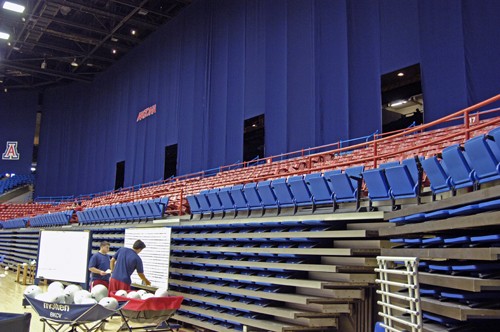Two years after head volleyball coach Dave Rubio first proposed the idea of making home games a closer experience for fans, his vision became a reality.
Arizona’s Red-Blue scrimmage welcomed the Wildcats back to McKale center and the fans to the now-familiar sight of the navy curtain hanging down from the rafters. The curtain — which essentially covers the middle and upper decks of the arena — made the stands feel occupied, even though there were only about one hundred fans watching.
“”I definitely think that the curtain makes everything completely different,”” junior setter Paige Weber said. “”It makes it a lot of an intimidating experience when you look out and you see the stands and they look more full than they do when it’s all empty at the top.””
The curtain originally started with the idea to move home volleyball games to a practice facility. When that idea didn’t work, Rubio set out to find a way to keep the players in McKale, but cut down on the empty seating.
“”McKale is where we always want to practice,”” said redshirt sophomore Elise Hendrickson. “”That’s where you want to be and play. I think the curtain’s a good idea because I know I don’t want to see us playing anywhere else.””
Taking inspiration from UCLA’s Pauley Pavilion, Rubio adapted the Bruins’ concept to form a ring around the arena with a curtain, instead of cutting the court in half.
Almost exactly one year has passed since the curtain, adorned with Arizona’s logo, was installed high in the rafters above the Lute and Bobbi Olson Court — a full season for fans and players to get used to the curtailed arena.
“”It’s such a difference,”” Rubio said. “”I’ve been here for a lot of years, and just dropping them down and bringing them in intimately like that is pretty nice.””
The curtain has helped to alter the home-game experience for both fans and players. Because it diminishes the seating capacity from 14,545 seats to 4,181, the crowd enjoys a closer view of game action. And because of their closer proximity, the crowd provides greater support for their team.
“”I think that (it) helps,”” Weber said. “”When (opposing teams) come in it makes it feel like our fans are sitting on top of them, they way we feel when we go to some of their gyms.””
The closeness of players to fans changes the atmosphere on court for the Wildcats. Cheering and loudness of the surrounding crowd helps Arizona gain the advantage on home court.
The proximity of the fans also alters the depth perception of the court for the players.
“”McKale is so huge; a little white ball in a big arena is not always the easiest (thing) to determine where the ball is going to exactly be,”” Hendrickson said.
“”When you’re playing in a big arena depth perception changes,”” Weber agreed. “”When you look out to the stands and you can see people sitting close to you, (it makes a difference) versus all the empty space above.””
It’s not just Arizona volleyball that’s taking advantage of the smaller arena. The curtain has made appearances at women’s basketball games and gymnastic events held in McKale.
Although head coach Niya Butts does not implement the whole curtain, women’s basketball home games have used the sides of the curtain to block off the east and west ends of the arena.
Rubio’s goal has worked out well for the volleyball team in their first season with the curtain. In a sport where followers are less numerous than in basketball, the curtain works to create an environment conducive to winning, fulfilling Rubio’s goal and pleasing fans — an all-in-one solution









